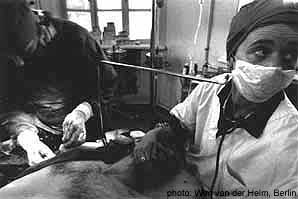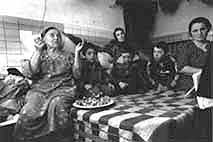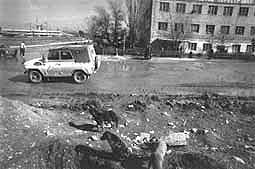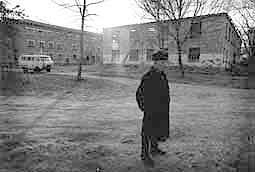|
[home]
|
documentary.de non-digital photography
|
Chechnya |
|
"In
Winter 1994/95 Russia and Chechnya fought a war over the independence
of Chechnya. The victims were as in most armed conflicts civilians. The
assignment focuses on the situation in Vedeno, Chechnya and the refugee
impact on neighbouring Dagestan and Inguchetia 1995."
|
| Chechnya is one of the former autonomous Soviet Republics
of the ex Soviet Union. Chechnya is a member of the Russian Federation,
and in 1991 became independent. Officially this declaration of independence
has never been recognized by the Russian authorities. Instead, the Russian
Constitutional Court ruled that Chechnya had violated the constitution.
Chechnya is a landlocked country situated in the Northern Caucasus surrounded by Russia and bordering Georgia in the south. It is located between the Black and the Caspian Seas but without access to them. It's area of 17,200 Km2 is rich in oil, chemicals, gold , iron and agricultural products. This is considered as to be one of the reasons for the war in 1994/95. |
 |
Vedeno, Chechnya
Thousands of people have been killed and more than 400,000 driven from
their homes since Russian forces stormed into Chechnya on December 11th
1994 to crush Dudayev's government and end the regions self-proclaimed independence.
 The Russians
controlled the border to Chechnya and let nobody pass it. We were driving
through the river for a while to avoid the checkpoints and once in Chechnya
we returned to regular streets. It w The Russians
controlled the border to Chechnya and let nobody pass it. We were driving
through the river for a while to avoid the checkpoints and once in Chechnya
we returned to regular streets. It w as
incredibly good weather, the land turned to spring. Inside Chechnya Médecins
sans Frontières (MSF) had set up a surgical center and had opened
an orphanage in Vedeno, 60 Kms south of Grozny. The hospital was vacant
for 4 years and MSF reopened it with its former local staff. It was then
running considerably well and the local population started trusting the
crazy foreigners that came to the country because of the war. as
incredibly good weather, the land turned to spring. Inside Chechnya Médecins
sans Frontières (MSF) had set up a surgical center and had opened
an orphanage in Vedeno, 60 Kms south of Grozny. The hospital was vacant
for 4 years and MSF reopened it with its former local staff. It was then
running considerably well and the local population started trusting the
crazy foreigners that came to the country because of the war.
Many Chechens were fighting independently of the forces loyal to Chechen President Dzhokhar Dudayev, and Dudayev's representative at the peace talks, Aslan Maskhadov, has warned that he did not control them. The Chechens seemed to have no real organization within their troops. They were hiding in the mountains with light weapons waiting for the Russians to move in. |
|||||||
|
|
Chasavjurt, Dagestan
 |
In Chasavjurt, Dagestan, which is near the chechen border, Médecins
sans Frontières provided assistance to a population of 60,000 displaced
people. Approximately 90%  of
the displaced were staying with families, but the rest of them was lodged
in schools and kindergartens. In February 1995 there were about 100 new
arrivals a day. The Teams work included the provision of basic health care,
the installation of epidemiological surveillance systems, sanitation and
the all-important support MSF gives to local medical structures. of
the displaced were staying with families, but the rest of them was lodged
in schools and kindergartens. In February 1995 there were about 100 new
arrivals a day. The Teams work included the provision of basic health care,
the installation of epidemiological surveillance systems, sanitation and
the all-important support MSF gives to local medical structures.
Russian officials said they have registered close to 300,000 refugees, or one quarter of chechnya's prewar population with another 100,000 staying with friends or relatives without registering. |
 The situation in Chasavjurt was quite tens because there were
already 38.000 chechen refugees in town. Part of the problem was that almost
every Caucasian man had his own gun and there was great sympathy for
the Chechen independence movement within the Dagestanian population. Rama The situation in Chasavjurt was quite tens because there were
already 38.000 chechen refugees in town. Part of the problem was that almost
every Caucasian man had his own gun and there was great sympathy for
the Chechen independence movement within the Dagestanian population. Rama da
was almost over and there was a huge fighting potential accumulated in the
city. The Russians knew this very well and they tried to keep the city tight.
There were Russian checkpoints all over the city and a big army da
was almost over and there was a huge fighting potential accumulated in the
city. The Russians knew this very well and they tried to keep the city tight.
There were Russian checkpoints all over the city and a big army  base
just outside of town. Traveling became difficult since every checkpoint
required seven permissions issued by 21 chiefs, subchiefs and subsubchiefs.
For the work of Médecins sans Frontières this meant it took
weeks to get the logistical and medical equipment out of customs
when the Russian administration found new excuses every day to block cars
and cargoes. Officials hide themselves behind the slogan: "Order from Moscow!". base
just outside of town. Traveling became difficult since every checkpoint
required seven permissions issued by 21 chiefs, subchiefs and subsubchiefs.
For the work of Médecins sans Frontières this meant it took
weeks to get the logistical and medical equipment out of customs
when the Russian administration found new excuses every day to block cars
and cargoes. Officials hide themselves behind the slogan: "Order from Moscow!". |
|
Nasran, Inguchetia
 We were driving for hours on straight roads. We were driving for hours on straight roads.  There was no tree and no bush growing amid this desert. Every 50 Km we would
find a settlement where forgotten people stared at the white flagged Landcruiser.
Then we entered into plain nothing again with the only thing to look at
are dry salt lakes and electric wires parallel to the route. The only interest
in this country is its oil. Caucasian fuel is considered to be the best
in the world. It all comes down to money. There is no other reason for a
war than money. At one a.m. we arrived in Nasran after passing 21 checkpoints.
There was no tree and no bush growing amid this desert. Every 50 Km we would
find a settlement where forgotten people stared at the white flagged Landcruiser.
Then we entered into plain nothing again with the only thing to look at
are dry salt lakes and electric wires parallel to the route. The only interest
in this country is its oil. Caucasian fuel is considered to be the best
in the world. It all comes down to money. There is no other reason for a
war than money. At one a.m. we arrived in Nasran after passing 21 checkpoints.
From Nasran, Inguchetia, MSF provided medical and non-medical aid to the displaced and supplied medicine and medical material to health structures in Nasran and Grozny. As in Dagestan many of these refugees were living with families but others found shelter in public buildings or in long rows of train wagons. In addition to the displaced people from the Chechen war, there was a large population of displaced persons from previous border conflicts. |
|
|
|
|||
|
[home]
|
[feedback]
|
||